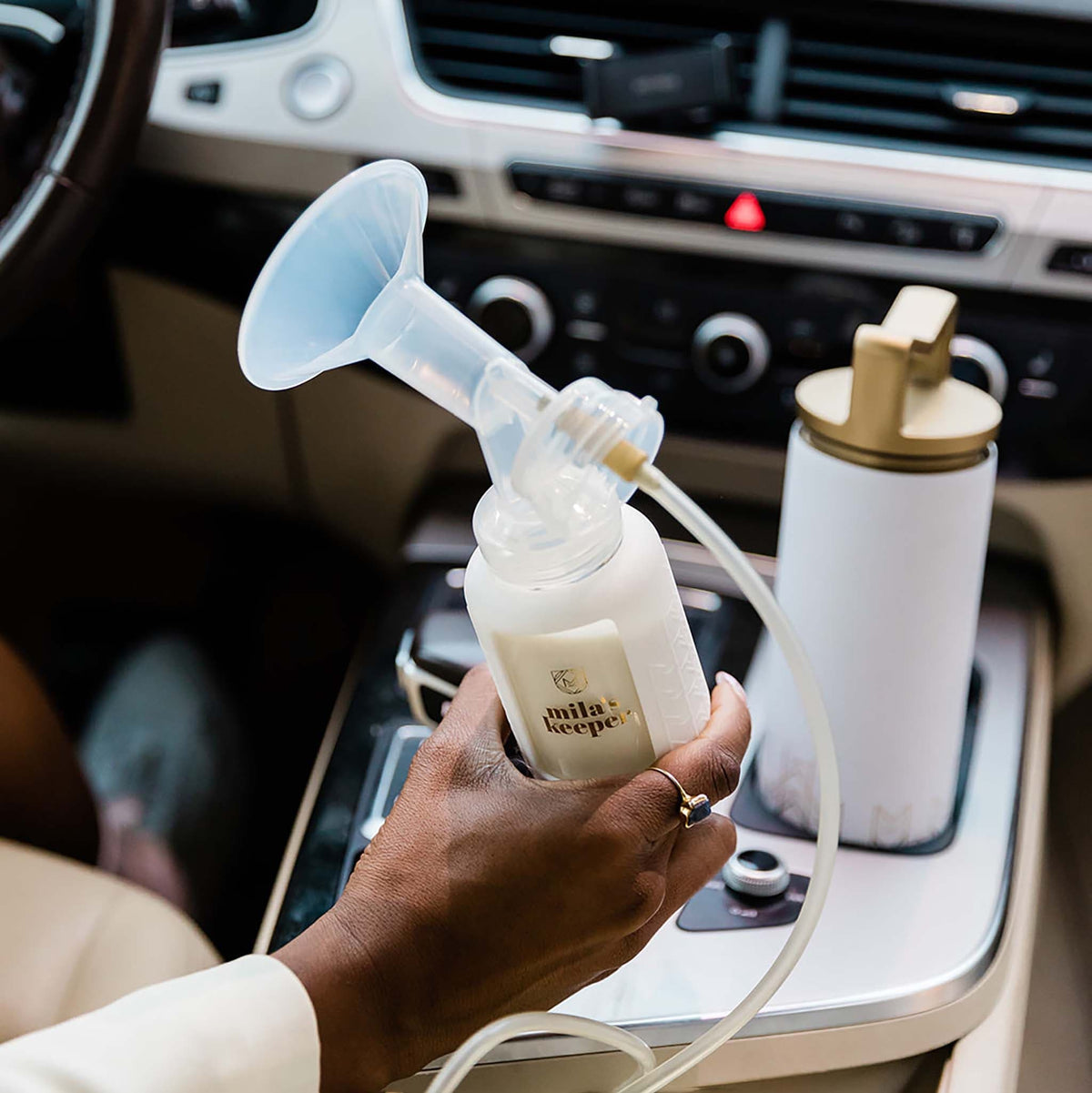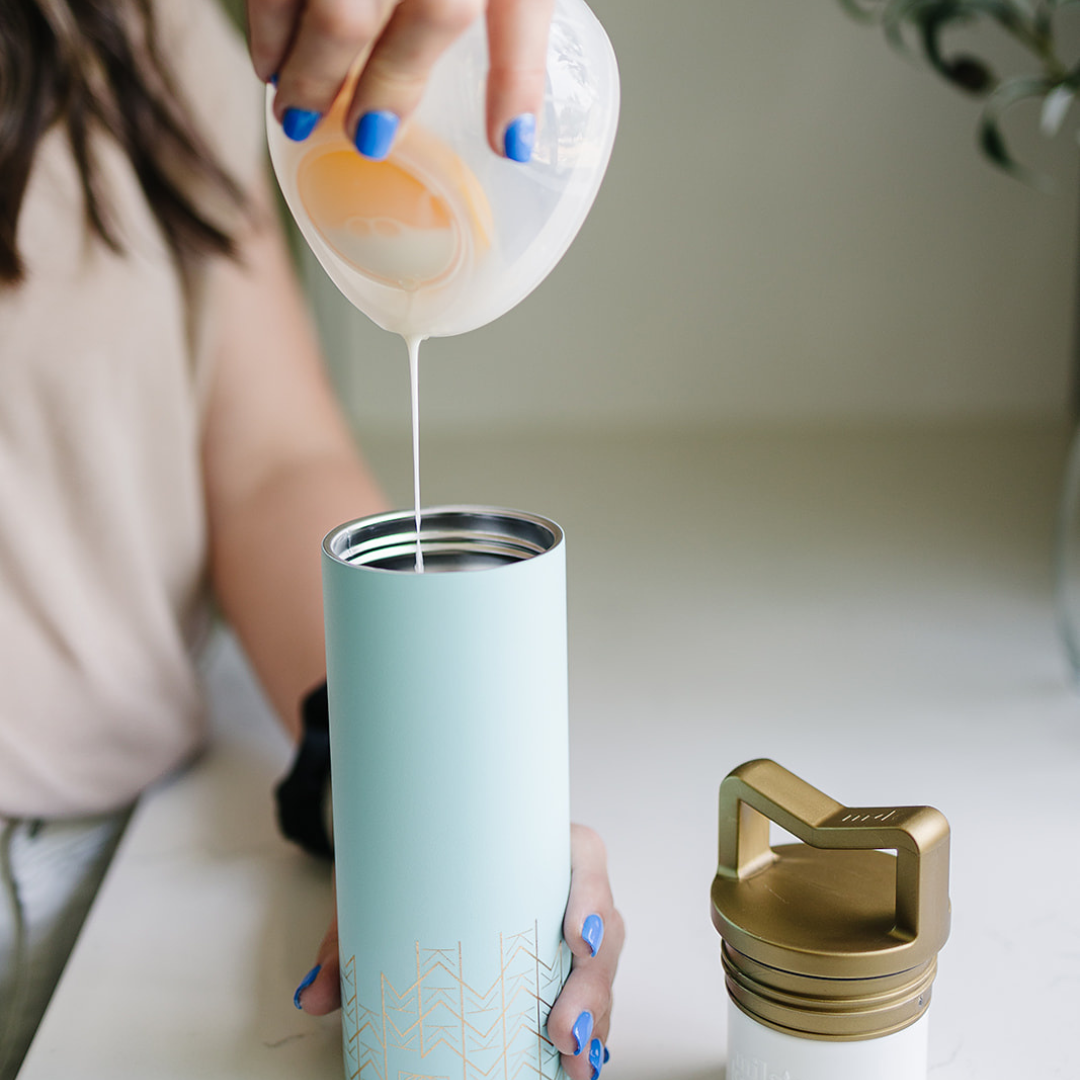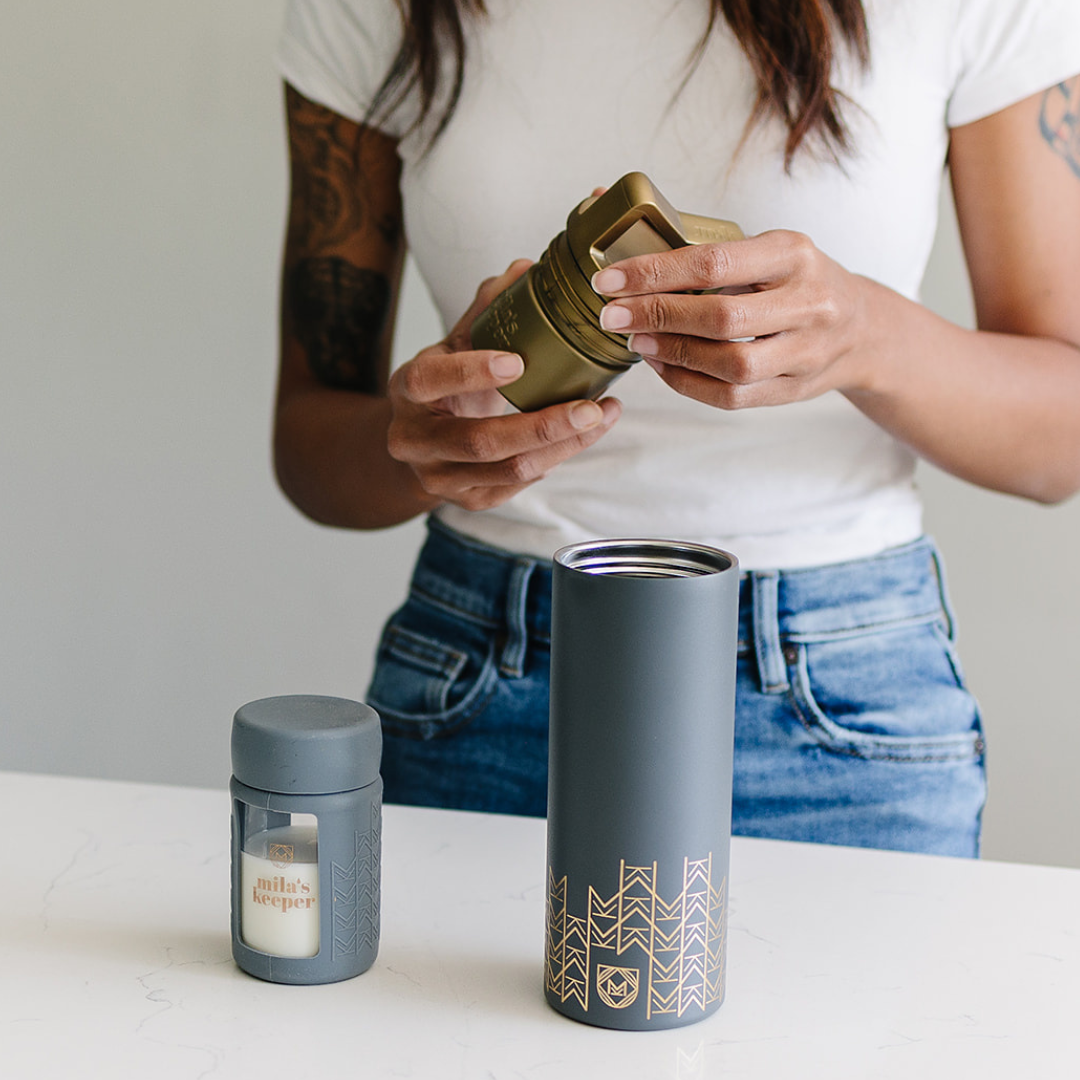A brief history of the baby bottle…
Like many things in our society, the practices and techniques of feeding our babies have evolved over time.
While breastfeeding and wet nurses were the primary ways to feed babies for a long period of time, archeologists have discovered pint-sized pottery believed to be bottles that were used to feed infants from as early as the Neolithic Period!
Between the 18th and 19th centuries, the use of feeding bottles became widespread and they were initially made from materials such as pewter. They didn’t know at the time that the milk was absorbing the metals and turning it into poison for their babies.
In 1920, a company called Corning, created a formula using borosilicate glass to develop Pyrex often known for its oven cookware. While Pyrex eventually became a household name, the products were not an immediate success due to the high cost of production of the glass. Eventually they also created a glass baby bottle that was so popular they had to transition the production of it from being manually blown to a semi-automatic machine to keep up with the demand.
Plastic baby bottles came out in the 1980s and have dominated the global baby bottle market since that time.
The point is, for as long as humans have been around, babies have had to be fed. While breastfeeding seems like the most practical way to do that, for many women it isn’t possible to always breastfeed.
There are times when the baby just won’t latch as it should, or maybe the mother’s milk production isn’t enough to exclusively breastfeed.
Many women find themselves returning to work soon after the birth of their baby, and will be pumping. The workplace hasn’t always been the most hospitable to nursing women, but we hope that with the passage of the PUMP Act, more women will feel encouraged and protected enough to be able to continue their breastfeeding journey once they do return to work.
Or, maybe a new mom just doesn’t want to breastfeed.
Whatever the reason, there has long been a need for a vessel to nourish our little ones.
Like with so many other things, the options for baby bottles these days seem endless. You can choose from plastic, silicone, stainless steel, or glass.
Here at Mila’s Keeper, we think that glass bottles make the best milk storage containers, specifically bottles made from borosilicate glass, which is the kind of glass used to produce our glass milk storage bottles.
So let’s delve into what borosilicate glass is and why it’s the best option for your breast milk!

What is Borosilicate Glass?
There are a few different kinds of glass that are commonly used to make glassware.
Soda-lime glass is probably the most common type of glass and it’s used for everyday glassware, like tumblers, wine glasses, and pint glasses.
Lead crystal glass is a type of glass that contains a high percentage of lead oxide and is commonly used for high-end glassware, such as crystal stemware and decanters.
Then there’s Borosilicate glass, which is a type of glass that is made from silica and boron trioxide. Overall borosilicate glass is more durable than other glass. The reason for this is because borosilicate glass has 3 main advantages over all types of glass in the market.
1. Low Thermal Expansion Rate
In 1880, a German scientist named Otto Schott developed borosilicate glass designed for laboratory and medical equipment called Borosilicate Glass. It was particularly unique for its quality of having a low thermal expansion rate, which means the glass could endure high heat and freezing temperatures with minimal expansion or without breaking. This was useful in a laboratory setting where beakers are are being heated by direct flames at extreme heat.
For instance, if you know you’re going to be pumping and working on getting a good supply into your freezer and you’re asking yourself, can you freeze breast milk in glass? You absolutely can freeze breast milk in our borosilicate glass bottles! You can then warm them up to the perfect temperature for your baby and then safely clean them in the dishwasher without them sustaining any damage or compromising any structure of the bottle.
2. Corrosion Resistant
Borosilicate glass is also very durable because it is considered corrosion resistant. Understanding its original setting in the laboratory, the glass needed to be resistant from reaction and corrosion from all kinds of organic and chemical material including water, acids, salt solutions, halogens and organic solvents. Silica, which makes up a high percentage of Borosilicate Glass, is incredibly resistant to chemical corrosion which was perfect for safely conducting scientific laboratory experiments. This non-corrosive quality of borosilicate glass also plays an important role in the medical and spacecraft industry.
So what does this mean in today's use such as with our glass baby bottles? When choosing glass bottles made of borosilicate glass, this means the glass will have high chemical resistance no matter what you put in the bottle and have greater clarity keeping its contents completely pure of of any leaching chemicals.
Due to borosilicate glass being non-porous, it also means that it doesn’t absorb odors or flavors and it doesn’t contain harmful chemicals like BPA or phthalates that are found in some plastic containers. It also doesn’t degrade over time, like plastic containers. These are exactly the key things that were important to us as well in making our own Mila's Keeper glass breast milk bottles.
3. Thermal Shock Resistance
Finally, the third key advantage or benefit of borosilicate glass is that it is thermal shock resistance. What does this mean? Essentially it means that it can go quickly from one temperature to another without breaking. Having said that, we will never recommend that you take a frozen glass bottle directly into a pot of boiling water immediately, as under uncontrolled, different circumstances, breakage could still occur. It is still comforting to know that unlike soda lime glass, borosilicate glass is certainly the safer glass to handle especially if you are storing breast milk in the freezer or warming milk in hot water.
So for the three reasons above, it's easy to understand why borosilicate glass over all glass is better for breast milk storage. Still not convinced, however, why glass in general is better over other materials? Let's take a quick comparison below to understand the other options.
Why is glass the best option for breast milk storage?
We’re always trying to do the best thing for our babies, using whatever information we have available to us.
What is considered safe or harmless for babies seems to change frequently.
Putting bumpers in the crib was once recommended so babies wouldn’t get a limb stuck between the crib slats, but then they were discouraged because babies could suffocate on the cushiony perimeter that was supposed to keep them safe.There was a time when smoking while pregnant was perfectly acceptable (crazy, right?).
You may have been told to stop drinking coffee while pregnant, but a friend going to a different OB-GYN was told it was fine to continue with her usual cup or two of coffee in the morning. Dark chocolate has long been touted as having many health benefits and as better for you than milk chocolate for years, but then all of a sudden it's laden with heavy chemicals like lead and cadmium and it’s now suggested that it should be avoided while pregnant.
The contradictions are endless and information is ever-changing.
Therefore as evident, there’s a lot of conflicting or outdated information out there and it’s up to you to suss out what’s accurate and best for you and your baby.
We’ve talked before about the use of plastic baby bottles and the harmful chemicals used in their production. Plastic baby bottles can contain chemicals such as bisphenol-A (BPA) which can leach into the contents of the bottle, potentially leading to health hazards for the baby. BPA is an endocrine disruptor, meaning it can mimic or interfere with the body’s hormones, leading to a range of potential health effects including developmental and reproductive problems.
While many manufacturers have stopped using BPA in their production of baby bottles, the commonly used alternative, bisphenol-S (BPS) is structurally similar to BPA and is used in many BPA-free products, including baby bottles.
Studies have shown that BPS can also have estrogenic activity, meaning it can mimic or interfere with the body’s hormones, similar to BPA. Some studies have also shown that BPS can be just as toxic as BPA to certain cells and organisms.Just because something is labeled as BPA-free, you shouldn’t automatically assume it doesn’t pose a risk.
Studies show that when plastic baby bottles are used to prepare formula, large quantities of microplastics are released into the bottle.
One study suggests that plastic bottle-fed infants could be consuming more than 1.5 million particles of microplastics per day on average.
On the other hand, glass is a safe and stable material that doesn’t react with breast milk or any other liquid. It's also a non-porous material, meaning it doesn't absorb odors or stains, making it easy to clean and sanitize.
Glass is also a great option for storing breast milk for long periods of time as it will not leach chemicals over time. Glass is also easier to clean, will never yellow since it is resistant to chemicals. This means it will also last longer. We also personally think it tastes better to drink from glass than plastic!
We know many people probably think of glass baby bottles as being similar to everyday glassware. Plenty of people probably hear about the use of glass baby bottles and an image of sharp shards of glass next to a tiny baby flashes in their mind. In reality, however, glass bottles are more durable and less likely to crack or break compared to plastic bottles.
While our 100% borosilicate glass bottles are extremely durable, we’ve taken the additional protective step of adding a silicone sleeve around it, making it easier to grip and safer to hold. The glass and silicone are both easy to clean and can be sterilized, which is important for maintaining the purity of the milk.
What about Silicone for Breast Milk Storage?
Silicone can also be a great way to store breast milk. Just like ice cubes, silicone trays are useful to store frozen, cubes of milk. They can be easily removed from silicone since it doesn't adhere to the foods and is resistant to temperature. Think silicone oven gloves and its resistance to high heat! The fact that it is resistant to temperature, however, is a reason why silicone itself can also be its weakness in terms of its ability to store breast milk effectively.
Silicone bottles are less effective than glass at maintaining the temperature of the liquid inside. Glass bottles are better at maintaining the temperature, which is beneficial for keeping the milk at the desired temperature especially when you are needing to chill milk quickly and maintain its temperature. So for example, chilling breast milk in a silicone container will take much longer than breast milk in a glass bottle. This is important if you are pumping during the day and it is essential to bring down the temperature of your pumped milk and sustaining it at cold temperatures. So glass will be much more effective for this purpose. If however you are doing this over a long period of time, such as in the freezer, the liquid will eventually freeze to your desired effect and either option will work well.
What about Stainless Steel?
Today we are also seeing many options for the use of stainless steel used for liquids and beverages in general. Stainless steel is a great option as well, but you must also do your homework about stainless steel because there are many different grade of steel too! While we won't cover this in this blog, we can say that 18/8 or 304 Stainless Steel is the most commonly used among household items due to its non-corrosive nature.
We use 18/8 Stainless Steel for its strength and non-corrosiveness in our MilKeeper®- insulated breast milk cooler. So be sure you know what kind of steel is being used in your bottles. Without knowing which kind of steel you are using to store liquids, you might end up getting corroded steel - think rusty nails!
While the use of 304 Stainless Steel is an excellent option, the one pitfall for milk storage is that you can't see through it! It is hard to see exactly how much milk is being stored, which is why it doesn't serve as the best material for a milk storage container when you need to measure how much to feed your baby. This can also be preference-based as some moms don't mind not knowing exactly how much milk was pumped!

How to transition from plastic bottles to glass bottles
If you’ve decided that glass bottles are the way you want to go when it comes to feeding your baby, great! What if you’ve made this decision after already purchasing plastic bottles? We’re here to help you figure out how to do that.
If you’ve already spent money on plastic bottles, it can be hard to justify spending the money on replacing them with glass bottles.
Borosilicate glass containers are costlier than other types of glass because it’s a more complicated and time-consuming product to produce.
You don’t have to buy a whole new set of glass bottles at once. Maybe it’s possible to buy a couple at a time until you’ve acquired the amount you need to solely use glass bottles.
You can use your HSA or FSA funds to purchase our glass breast milk bottles.
Keep in mind that our glass milk storage bottles come in two different sizes (standard and wide neck) and are compatible with many popular breast pumps and nipples like Medela, Evenflo, and Avent. The wide neck option is best for the Spectra, Motif and hands-free pumps.
So even if you’ve already invested in a pumping system, it’s not necessary to start from scratch- incorporating our glass bottles should be pretty seamless.
Our glass bottles can be used safely in the dishwasher, along with the silicone sleeve and lid. Being able to conveniently wash the entire bottle and its parts in the dishwasher means you don’t have to start off with a ton- you can feel comfortable washing them as many times as you need to reuse them.
What to do with the plastic bottles you’re no longer using? We know that plastic is filling up our landfills and that it doesn’t always get recycled like we’re led to believe. So what useful things can you do with them?
A quick search on Pinterest shows the clever ways people are repurposing their plastic baby bottles for their art supplies. You can paint them and store crayons, colored pencils, and markers in them. Or you could store small craft items in them like glitter and stickers.
There is also still a high demand for plastic baby bottles and they can be sold or given to somebody that wants to use them.

Borosilicate glass bottles can last a lifetime!
Glass bottles shouldn’t be thought of as single-use items either. They should be useful long after they’ve nourished your baby with breast milk.
They can make excellent (and cute) travel containers for your baby’s snacks when they’re older. Fill them up with some berries or peas and be on your way!
They don’t have to be repurposed just for your kids either. Glass bottles can be the perfect container to store your homemade pesto, jams, or small-portion leftovers.
We know all you busy mamas and mamas-to-be out there have a lot of decisions to make and information to sort through when it comes to feeding your babies. We hope we’ve provided you with the insight needed to help make the decision about which bottles to use a little easier. As always, we strive to make things a little easier for you!
Keep Reading related blog: 10 Facts about the Dangers of Plastic to Moms and Babies
--
A female-designed and female-run company, Mila's Keeper is on a mission to empower women to thrive during their breastfeeding journey by offering reusable, eco-friendly breast milk storage solutions for their day-to-day needs. Get the latest tips and info on Mila's Keeper products by following us on Facebook, Twitter, Instagram, Pinterest, and LinkedIn.
























